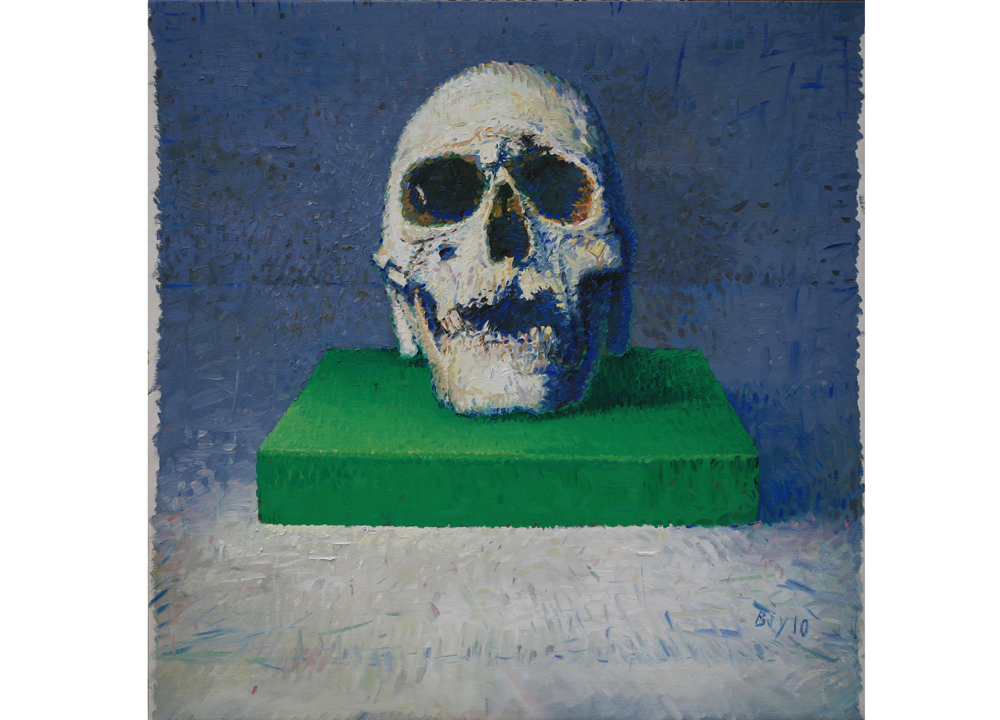
‘Painting is an attempt to use traditional techniques while constantly reinventing the different elements on the canvas; it's a process of constantly revising aesthetic standards through personal experience.’
-- Bi Jianye
Bi Jianye is a painter of considerable skill in the manner of Jla Aili. Both artists were, in fact, trained at the same academy and have certain similar interests, as evident in the style of painting that they have produced to date. Importantly, Bi Jianye demonstrates a slmilar ability to experiment with technique and to turn his hand from one style and texture to another in order to achieve the perfect expression of his idea. He has said that he relies upon personal experience for inspiration, thus, from his earliest paintings he has drawn on memories as well as photographs and actual places, which are combined or reworked at will in the final compositions. The final result has been described as being often accompanied in this early phase by "the kind of melancholy yearning for a past evident amongst his generation". That melancholy is little in evidence in the vibrant works that Bi Jianye combines as his NOTEBOOK for HIVE.
Viewers who saw the paintings he presented at Platform China in March 2011 as part of 19 Solo Exhibitions would not necessarily recognize the new works here in HIVE as being by the same artist. In those paintings it appears that many elements had been stripped away to leave the bare minimum of content, often centered on a single tree or a box, or a tree and a box. In an odd juxtaposition for which there is no clear explanation. That form of odd juxtaposition is also present in NOTEBOOK. in a group of four very different and surprisingly intimate paintings, but there is none of that minimalist in terms of the colours used to paint the works, or of the objects depicted. Instead, NOTEBOOK offers an almost overwhelming density of elements, each painted with a meticulous attention to detail and a startling sense of realism. Here, too, there is layer upon layer of painted objects to pick through, each of which feels loaded with meaning. Whilst the nature of that meaning will appear different to different mindsets, in both the centre piece and the small canvas and paper works that accompany it, one element remains clear to all. That is an air of disquiet and a tremor of fear.
Bi Jianye. who hails from Liaoning province, grew up in a period of unprecedented change that is evident across all China, and especially in the urban environment. In the mid-1990’s. Liaoning province was in serious economic decline as its industrial base was put through a period of modernization and the grist of labour reduction in the name of greater efficiency. Personal fortunes experienced dramatic change in step with the social change that encouraged families to become homeowners and new businesses to replace the old. The impact of that change as expressed in art does not belong to Bi Jianye alone. Yet for his generation it has an universal presence and is often felt by viewers as a sense of anxiety, a mixture of excitement and foreboding. These are tangible forces in NOTEBOOK. Why else would Donald Duck be wandering aimlessly in the massive expanse of lush forest that covers the main painting here, which Bi Jianye entitled Princess but with a huge grin on his face? Of course Donald grins because he is in this beautiful mesmerizing place: a forest that is green, so green, and full of wonderment. But just as that wonderment draws the viewer in, they find themselves staring at a skull posted atop a cane, and reminiscent of so much historic horror-execution, cannibals, wild peoples lost in remote realms of nature, and horror movies that excel in juxtaposing scenes of extraordinary beauty with the most macabre and terrifying of events. That sense of terror echoes in the two barbed fragments of the plant life in the small watercolour works. The small oil painting of the skull is perhaps the most literal element of this piece and the least surprising for the times, given the prevalence of skull imagery in the work of contemporary artists like Damien Hirst and designers like Alexander McQueen and Thomas Wylde. But juxtaposd with the monumental Princess it all makes sense. Bi Jianye’s paintings acquire a potent force. Like deadly nightshade or a Venus flytrap, as he wields a beautiful aesthetic poise to an "other" end entirely.
